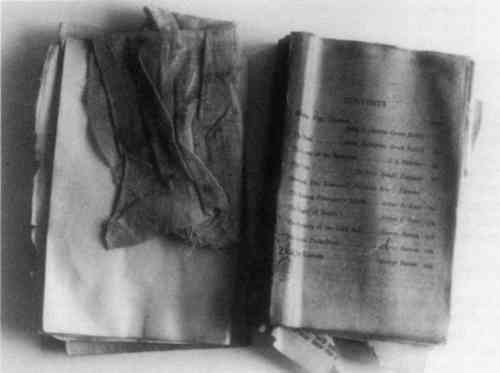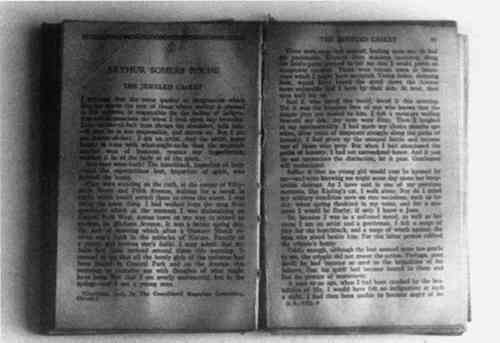VAPOR PHASE CONSOLIDATION OF BOOKS WITH THE PARYLENE POLYMERSBruce J. Humphrey
7 IMMERSION TESTONCE THE BOOKS WERE TREATED with parylene it was necessary to devise a means of rapidly determining the extent of treatment in each volume. Other than a slight change in the “feel” of the paper, it was difficult to tell a parylene treated volume from one that had not been treated. An immersion test was set up whereby each volume was placed upright in a container of water. The pages were “fanned” open as much as possible to insure that the water would penetrate between the pages. Weights were also placed on top of the The books were left in water for periods of up to 4 months. They were checked on a weekly basis for evidence of water damage. Those areas not penetrated by the polymer darkened as the water penetrated them (Fig. 5). The results of these preliminary tests indicate that the best overall coverage and penetration is achieved by using a combination of Parylene “N” and Parylene “C”. The ratio used in this experiment was 1 to 1. Other ratios may have varying results. In this category the best overall results were obtained in books treated at the .005 and .006 amount of parylene. These books showed evidence of penetration and coating down to the binding, the area that is most difficult to reach with polymerization treatments. 7.1 Additional Results of Immersion TestingAs stated earlier, the purpose of the immersion experiment was to determine the proper amount of dimer to use in order totally to treat a bound volume. Some interesting additional conclusions can also be derived from this study. Figures 7 and 8 show treated and untreated volumes after four months of total immersion after which they were removed from the water and placed in plastic boxes while still wet. They were left in the boxes for an additional three months, after which these photographs were taken.
The untreated volume is in very poor condition, perhaps a total loss. The cover was destroyed during the first few weeks of immersion due to dissolution of the glues used in binding. The pages can be separated only with great difficulty. They have the consistency of wet tissue in that they come apart at the slightest touch. The paper is also much darkened in color. By contrast, the treated book has survived intact. The glue has been dissolved but the parylene has acted as a consolidant. Even the gold stamping on the spine has been held in place. The remarkable thing to note is the excellent condition of the pages. Their color is quite natural and they have absorbed little if any water. Most of the resident moisture is surface or interfibrous entrapment, held much like a sponge holds water. The pages are not stuck together and can even be “fanned” with the fingers as though the book were dry. One of the volumes which had been given a heavier parylene treatment was placed in a vacuum oven and baked dry at 90�C. The book came out in very good condition. There was no water spotting or discoloration of the pages nor was there any evident weakening of the paper. It is realized that this is not a standard conservation practice. The object here was to stress the test book and look for evidence of failure on the part of the coating. One other phenomenon noted during the immersion tests was the lack of swelling on the part of parylene treated books. It appears that the hydrophobic properties of the polymer may aid in the prevention of swelling during immersion. No comparison tests were made, nor were any books immersed in the closed state. It would seem reasonable to assume from these tests and observations that parylene treated books would have a better chance to survive flooding or high humidity situations. |

